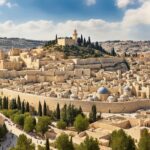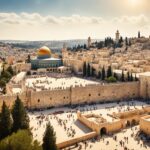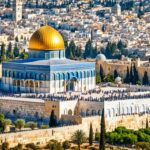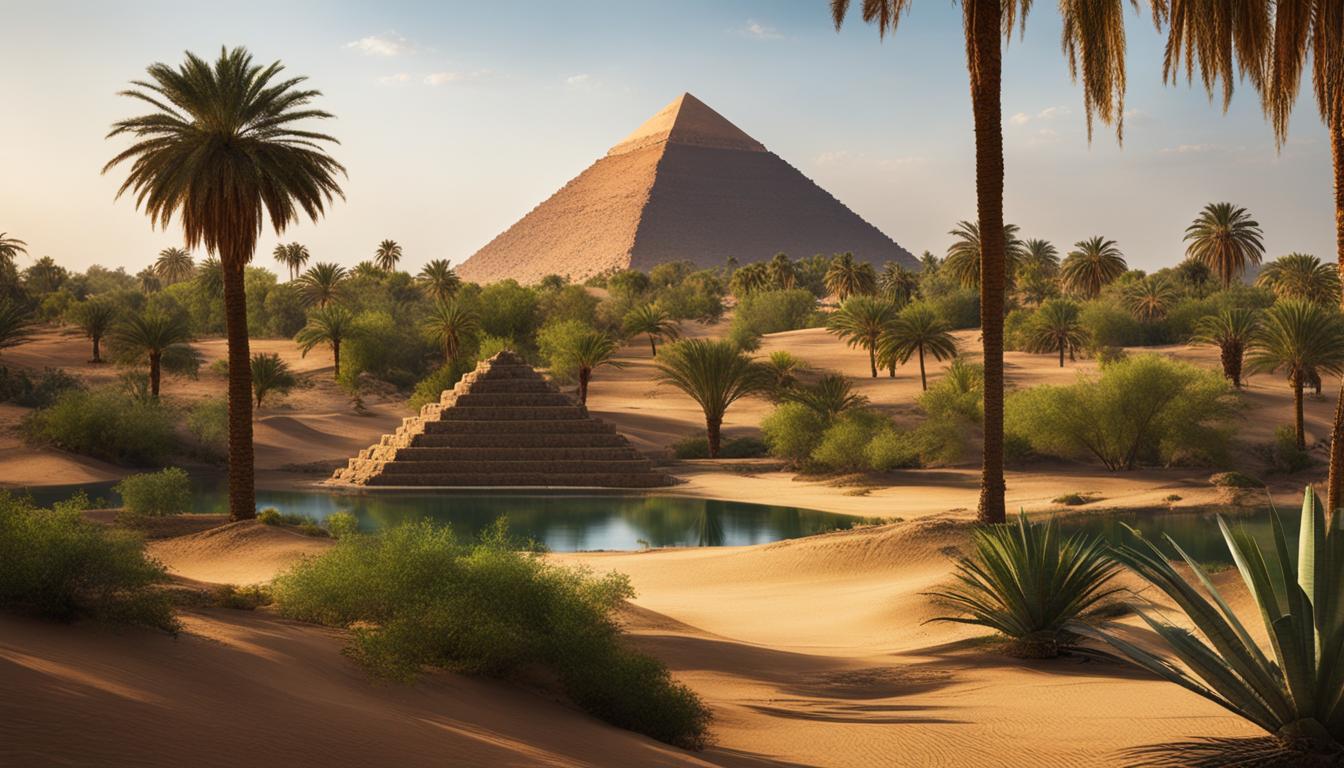Israel is a country steeped in history and spirituality, with a multitude of religious sites that are of great significance to people from various faiths. These holy sites in Israel are not only landmarks but also windows into the rich cultural heritage of the region.
Key Takeaways:
- Israel is home to numerous significant religious sites.
- These sites have deep historical and spiritual significance.
- They attract pilgrims and tourists from around the world.
- Some famous religious landmarks include the Western Wall, Dome of the Rock, and Church of the Holy Sepulcher.
- Visiting these sites provides a unique and profound spiritual experience.
The Western Wall (Jerusalem)
The Western Wall, located in Jerusalem, is one of the most sacred Jewish sites in the world. It is part of the ancient retaining wall built by King Herod around the Temple Mount. The massive stones of the Wall serve as a testament to the grandeur of the ancient Jewish world. Jews and visitors from all over the world come to pray and leave written prayers in the crevices of the Wall. It symbolizes the eternal connection between the Jewish people and the land of Israel.
Key Features of the Western Wall
| Location | Jerusalem |
|---|---|
| Significance | Sacred Jewish site |
| Builder | King Herod |
| Purpose | Retaining wall for the Temple Mount |
| Visitor Experience | Praying, leaving written prayers |
Visiting the Western Wall is a deeply spiritual experience for Jews, who consider it a place of connection with God and an opportunity to offer prayers and messages of hope. The Wall’s historical and religious significance makes it a must-visit destination for pilgrims and tourists exploring Jerusalem’s rich cultural heritage.
Dome of the Rock (Jerusalem)
The Dome of the Rock is a stunning Islamic shrine located in Jerusalem. It was built in 691 AD and is believed to cover the rock where Abraham prepared to sacrifice his son or the place from which Prophet Mohammed ascended to heaven. The golden dome and intricate architectural details make it a prominent landmark in the city. The Dome of the Rock holds great religious significance for Muslims and is considered one of the holiest sites in Islam.
The Dome of the Rock is an architectural masterpiece that encapsulates the beauty and spiritual magnificence of Islamic art and culture. Its golden dome shines brightly, drawing visitors from all over the world to witness its grandeur firsthand.
The Dome of the Rock’s historical and religious significance cannot be overstated. It stands as a symbol of Jerusalem’s rich cultural heritage and the deep spiritual connection between Muslims and the city. The sacredness of the site attracts countless pilgrims and visitors who come to experience the serenity and reverence that permeates the air.
“The Dome of the Rock is a testament to the architectural brilliance of its time and serves as a source of inspiration for generations to come.”
The interior of the Dome of the Rock is equally breathtaking, adorned with intricate mosaics and calligraphy that depict scenes from Islamic history and religious texts. The sense of tranquility and reverence inside the shrine is palpable, providing a space for contemplation and spiritual reflection.
It is important to note that while the Dome of the Rock holds immense religious significance for Muslims, it is also a revered site for scholars of art, history, and architecture. Its unique blend of Byzantine, Persian, and Umayyad influences has made it an iconic representation of Islamic art and culture.
Visiting the Dome of the Rock is a transformative experience that allows individuals to immerse themselves in the rich history and spirituality of Jerusalem. It serves as a reminder of the city’s diverse religious heritage and the importance of fostering interfaith dialogue and understanding.
Al Aqsa Mosque (Jerusalem)
The Al Aqsa Mosque, situated on the Temple Mount in Jerusalem, is a significant Muslim place of prayer. It is the third-most-important Muslim site after Mecca and Medina. Built in 720 AD, the mosque is an architectural marvel, with intricate designs and a large prayer hall that can accommodate thousands of worshipers. It holds great spiritual significance for Muslims and is a popular destination for those undertaking religious pilgrimage.

The Al Aqsa Mosque, often referred to as the “Farthest Mosque,” is an iconic landmark in Jerusalem. Its majestic dome and stunning architecture make it a symbol of Islamic heritage. The mosque is not only a place of prayer but also serves as a center for religious and cultural activities.
Inside the Al Aqsa Mosque, visitors can marvel at the intricate carvings, beautiful mosaics, and exquisite tile work. The spacious prayer hall provides a tranquil environment for worship, connecting believers to their faith and fostering a sense of unity among the Muslim community.
“The Al Aqsa Mosque holds immense spiritual significance for Muslims around the world. It is a place where the faithful come together to seek solace, offer prayers, and deepen their connection to God.”
Adjacent to the mosque is the Dome of the Rock, another iconic structure in Jerusalem. The golden dome of the shrine shines brightly in the sun, attracting visitors from all corners of the globe. Both the Al Aqsa Mosque and the Dome of the Rock are integral parts of the holy complex on the Temple Mount, making it a cherished place for Muslims and a symbol of Jerusalem’s religious diversity.
Key Features of the Al Aqsa Mosque:
- An expansive prayer hall with a capacity to accommodate thousands of worshipers.
- Exquisite architectural details, including intricate carvings and beautiful tile work.
- A symbol of Islamic heritage and religious unity.
Al Aqsa Mosque: A Place of Spiritual Reverence
The Al Aqsa Mosque holds a special place in the hearts of Muslims worldwide. It is a revered site where the faithful come to pray, meditate, and connect with their Creator. The mosque’s historical significance, breathtaking architecture, and spiritual ambiance make it an essential destination for those seeking a deeper understanding of Islam and its traditions.
| Year Built | No. of Worshipers | Architectural Style |
|---|---|---|
| 720 AD | Thousands | Islamic |
Despite its rich history, the Al Aqsa Mosque faces ongoing challenges and tensions due to its location in a region of geopolitical significance. However, its enduring presence as a place of worship and spiritual solace serves as a testament to the resilience and devotion of the Muslim community.
Church of the Holy Sepulcher (Jerusalem)
The Church of the Holy Sepulcher, located in Jerusalem, is Christianity’s holiest place. It encompasses the traditional sites of Jesus’ crucifixion, burial, and resurrection. The church, built in 330 AD, is a significant pilgrimage site for Christians from different denominations. It is divided among various Christian sects like the Greek Orthodox, Roman Catholic, and Armenian Orthodox, each having their designated areas within the complex.
The Church of the Holy Sepulcher holds immense historical and religious importance for Christians worldwide. It is a pilgrimage destination where believers can connect with the foundational events of their faith. The church’s layout and numerous chapels reflect the various aspects of Jesus’ crucifixion and resurrection, offering a multi-dimensional experience to visitors.
Within the church, the Chapel of Calvary is believed to be the site of Jesus’ crucifixion, while the Stone of Anointing is where his body was prepared for burial. The Aedicule, a small structure within the church, encloses the tomb where Jesus is said to have been laid to rest before his resurrection. These sacred spaces are meticulously maintained and provide a profound spiritual atmosphere for worship and reflection.

The Division of the Church
Due to the long history of the Church of the Holy Sepulcher, it is shared by different Christian denominations, each having their designated areas and responsibilities within the complex. The division is maintained under a complex arrangement known as the Status Quo, which has been in place since the 18th century.
| Denomination | Assigned Area |
|---|---|
| Greek Orthodox | Main entrance, Katholikon (Greek Orthodox Church), the Aedicule |
| Roman Catholic | Chapel of the Nailing, Chapel of the Finding of the Cross, Chapel of the Apparition |
| Armenian Orthodox | Chapel of the Division of Robes, Chapel of St. Helena, Chapel of the Prison of Christ |
| Other Denominations | Chapel of the Franciscan Monastery |
This unique arrangement allows for a shared worship space, fostering unity and respect among different Christian traditions. Visitors to the Church of the Holy Sepulcher can witness the coexistence of these denominations and experience the diverse expressions of Christian faith within the same holy site.
“The Church of the Holy Sepulcher stands as a testament to the enduring significance of Jesus’ life, death, and resurrection. It is a place where Christians can connect with the core tenets of their faith and find solace in the deep spiritual heritage it represents.”
Mount of Olives (Jerusalem)
The Mount of Olives is a significant religious site located east of the Old City of Jerusalem. It offers a breathtaking view of the entire city and holds deep religious significance for Jews and Christians alike. According to tradition, Jesus wept here and ascended to heaven, making it an important site for Christians. For Jews, the Mount of Olives is also home to the most important graveyard in Judaism, with thousands of years of history.
Visitors to the Mount of Olives can experience a sense of reflection and spiritual connection as they explore its scenic landscapes and historic landmarks. The site’s serene atmosphere and panoramic views create a peaceful setting for contemplation and meditation.
| Religious Significance | Visitor Experience |
|---|---|
| • Place of ascension for Jesus | • Breathtaking view of Jerusalem |
| • Important Jewish burial site | • Peaceful and reflective atmosphere |
| • Symbol of religious history | • Landscaped gardens and ancient olive trees |
Whether you’re drawn to its religious significance, the stunning view, or the sense of history that permeates the area, a visit to the Mount of Olives is an enriching experience that allows you to connect with the spirituality and timeless traditions of Jerusalem.
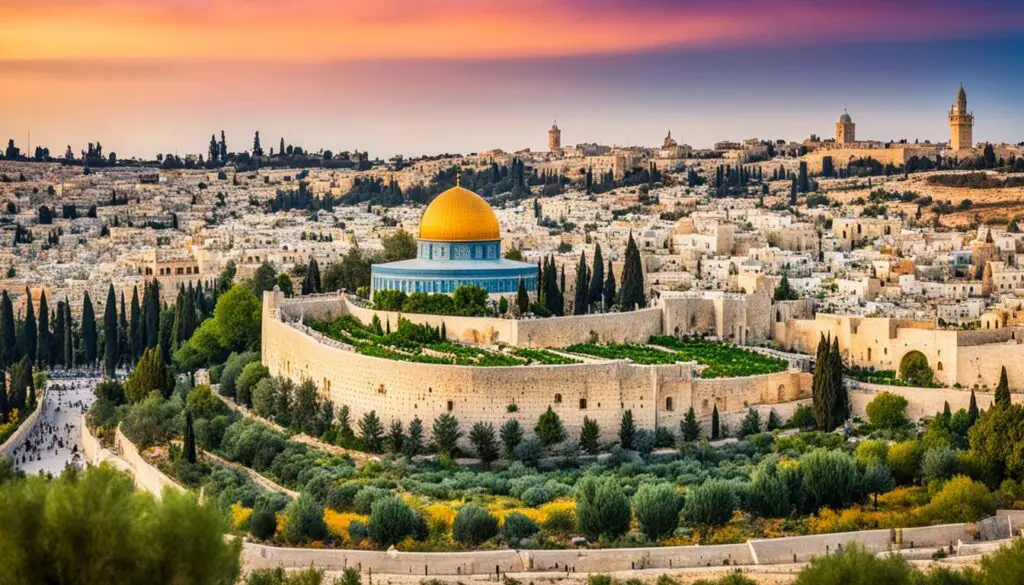
Explore the Mount of Olives and discover the stories and spirituality that have made it such a revered location for thousands of years.
Baha’i Gardens (Akko)
The Baha’i Gardens in Akko hold a special place in the hearts of followers of the Baha’i faith. Situated near the tomb of Baha’ullah, the founder and prophet of the Baha’i faith, these meticulously maintained gardens offer a serene and tranquil atmosphere for visitors seeking spiritual solace.
The terraced gardens, adorned with beautiful flowers and shrubs, provide a picturesque setting for contemplation and reflection. As you stroll through the carefully landscaped paths, you will be captivated by the beauty and harmony of nature, creating an opportunity for inner peace and rejuvenation.
The Baha’i Gardens in Akko have become a popular destination for religious tourism in Israel. Visitors from all over the world come to explore this sacred space and immerse themselves in the teachings of the Baha’i faith. Whether you’re a follower of the Baha’i faith or simply interested in experiencing the tranquility of these gardens, a visit to Akko is a must during your religious pilgrimage in Israel.

The Spiritual Retreat Amongst Nature
The Baha’i Gardens in Akko are more than just a beautiful garden; they are a spiritual retreat amidst nature’s beauty. “The earth is but one country, and mankind its citizens.” – Baha’u’llah
This quote by Baha’u’llah, the prophet of the Baha’i faith, embodies the inclusive and harmonious spirit of the Baha’i Gardens. It reminds us of the importance of unity and the interconnectedness of humanity. The gardens provide a sacred space where people from all backgrounds can come together, putting aside differences and embracing the oneness of mankind.
The Baha’i Gardens in Akko serve as a symbol of peace, love, and unity, inviting visitors to connect with their inner selves and find harmony with the world around them. Whether you’re a believer or simply seeking tranquility, a visit to these gardens is a transformative experience that will leave a lasting impression on your soul.
Immerse yourself in the beauty and serenity of the Baha’i Gardens in Akko and discover the profound spiritual essence they hold for followers of the Baha’i faith and all those in search of enlightenment.
Baha’i Shrine & Gardens (Haifa)
The Baha’i Shrine & Gardens in Haifa is a remarkable testament to the Baha’i faith and a must-visit destination for spiritual seekers. This sacred site commemorates Bab Mirza Ali Muhammad, a martyr of the Baha’i faith, and offers visitors a profound and tranquil experience.
The shrine itself is a breathtaking architectural marvel, showcasing intricate designs and exquisite craftsmanship. Its grandeur and beauty serve as a reflection of the profound spiritual beliefs of the Baha’i community.
As you explore the shrine, you will be captivated by the panoramic views of Haifa and the stunning Mediterranean Sea. The harmonious blend of natural landscapes and meticulously landscaped gardens creates a serene and peaceful ambiance, ideal for contemplation and reflection.

The gardens surrounding the shrine are a testament to the artistry and devotion of the Baha’i community. Lush greenery, vibrant flowers, and meticulously maintained pathways invite visitors to immerse themselves in the beauty and tranquility of their surroundings.
Whether you are a follower of the Baha’i faith or simply seeking a deeper connection to spirituality, the Baha’i Shrine & Gardens in Haifa is a magnificent site that will leave a lasting impression on your soul.
Baha’i Shrine & Gardens – Key Highlights:
- Architectural masterpiece honoring the Baha’i faith
- Breathtaking views of Haifa and the Mediterranean Sea
- Meticulously landscaped gardens offering serenity and peace
- Opportunity for contemplation and reflection
| Opening Hours: | 9:00 AM – 5:00 PM |
|---|---|
| Location: | Mount Carmel, Haifa, Israel |
| Contact: | +972-4-8313131 |
| Website: | Visit Official Website |
Church of the Nativity (Bethlehem)
The Church of the Nativity in Bethlehem is a place of immense historical and religious significance. As the oldest surviving church in the Holy Land, it holds a special place in the hearts of believers and attracts numerous pilgrims from around the world. According to tradition, the church marks the spot where Jesus Christ was born, making it the birthplace of Jesus and a focal point for Christians.
The Church of the Nativity is renowned for its remarkable mosaics and frescoes that adorn its interior, showcasing the artistic splendor of centuries past. These intricate works of art serve as a visual testament to the profound spiritual significance attached to this sacred site.
“The Church of the Nativity in Bethlehem holds immense spiritual significance, as it is believed to be the birthplace of Jesus Christ. Its age-old structure and breathtaking artwork make it an important pilgrimage destination for Christians worldwide.”
Pilgrims visiting the Church of the Nativity can partake in guided tours, explore the sacred grounds, and experience the serenity of its hallowed halls. The church’s historic existence and its role in preserving the memory of Jesus’ birth make it a cherished site for believers seeking to deepen their faith.
Mosaics and Frescoes
The Church of the Nativity is renowned for its stunning mosaics and frescoes, which showcase intricate detailing and vibrant colors. These artistic masterpieces depict scenes from the biblical narrative, allowing visitors to immerse themselves in the visual representation of the birth of Jesus.
Pilgrimage and Religious Significance
For Christians, the Church of the Nativity is a destination of utmost importance, as it represents the birthplace of their savior. Every year, countless individuals embark on pilgrimages to Bethlehem to pay homage to Jesus and find solace in the sacred atmosphere of the church. The visit to the Church of the Nativity serves as a profound spiritual experience, strengthening the connection between believers and their faith.
| Key Features | Highlights |
|---|---|
| Oldest surviving church in the Holy Land | Experience the history and heritage of Christianity |
| Stunning mosaics and frescoes | Immerse yourself in the vibrant artwork of the church |
| Birthplace of Jesus Christ | Connect with the foundational event of Christianity |
| Pilgrimage destination | Embark on a spiritual journey to deepen your faith |
Tomb of King David (Jerusalem)
The Tomb of King David, located near the Zion Gate in the Old City of Jerusalem, is a revered Jewish holy site. It holds immense significance for followers of Judaism and is considered the burial place of King David, a prominent figure in Jewish history. The tomb attracts pilgrims and visitors from around the world, who come here to pay their respects and engage in prayer and reflection.
Surrounded by ancient stone walls, the Tomb of King David exudes a sense of sacredness and tranquility. Inside the tomb, visitors can find a deep connection to Jewish traditions and history as they honor the memory of King David, the shepherd boy who became a great king and poet.
This iconic site stands as a testament to the enduring legacy of the Jewish people and their deep connection to Jerusalem. Through its historical and religious significance, the Tomb of King David serves as a spiritual anchor, inspiring devotion and reverence among visitors.
Temple Mount (Jerusalem)
The Temple Mount, also known as Haram al-Sharif, is a significant Islamic holy site located in Jerusalem. It holds great religious and historical importance for Muslims around the world. The site is home to two magnificent structures, the Dome of the Rock and the Al Aqsa Mosque, which are key symbols of Islamic architecture and faith.
According to Islamic tradition, the Temple Mount is believed to be the spot from where Prophet Mohammed ascended to heaven during his Night Journey. This event holds immense spiritual significance for Muslims and is commemorated with religious fervor.
The Dome of the Rock, with its distinctive golden dome, is a breathtaking sight and has become an iconic symbol of Jerusalem. It covers the rock where Prophet Mohammed is believed to have ascended to heaven and is adorned with intricate calligraphy and geometric patterns. The Al Aqsa Mosque, located adjacent to the Dome of the Rock, is one of the oldest mosques in the world and serves as a place of worship for Muslims.
Every year, millions of Muslims from across the globe visit the Temple Mount to offer prayers and connect with their faith. The serene atmosphere and historical grandeur of the site create a sense of awe and reverence.
The Temple Mount stands as a testament to the deep-rooted religious and cultural heritage of Jerusalem. Its significance extends beyond religious boundaries, as it also holds historical and political importance. The complex history and ongoing religious and political dynamics surrounding the Temple Mount make it a site of great interest and importance.
Conclusion
Israel, with its diverse range of religious sites, offers a truly unique and profound spiritual experience. Whether it’s praying at the Western Wall or exploring the historical significance of the Church of the Holy Sepulcher, religious tourists and pilgrims have an array of options to choose from. These sites cater to the religious tourism needs of various faiths, making Israel a sought-after destination for those seeking a deeper connection with their beliefs.
With its rich religious and historical heritage, Israel has become a top choice for religious tourism. Visitors can immerse themselves in the sacred ambiance of the Dome of the Rock or discover the tranquility of the Baha’i Gardens in Akko and Haifa. Each site holds its own significance, offering a profound experience that touches the hearts and souls of pilgrims from around the world.
Religious pilgrimages to Israel can be a transformative journey, allowing individuals to reconnect with their faith and spirituality. Whether it’s the religious landmarks in Jerusalem or the famous Church of the Nativity in Bethlehem, every corner of Israel holds a story waiting to be explored. These religious pilgrimage sites provide a sacred space for reflection, devotion, and introspection, offering a deeply meaningful experience to all who visit.
When it comes to religious tourism and pilgrimage, Israel’s vibrant and diverse religious sites make it a destination like no other. From the ancient ruins to the breathtaking architecture, every corner of this holy land is steeped in history and spirituality. Whether you are seeking solace, enlightenment, or a deeper connection with your faith, a journey to Israel’s religious sites is sure to leave a lasting impression on your heart and soul.


